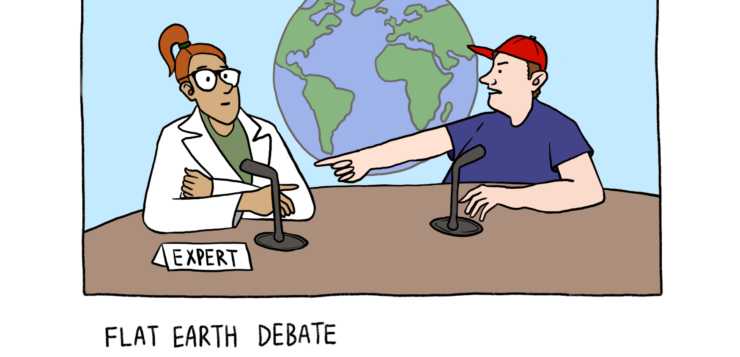Disclaimer: The views expressed within this article are entirely the author’s own and are not attributable to Wessex Scene as a whole.
Flat-earthers are a long-standing staple of the conspiracy world and most of us are familiar with their existence. However, in recent years the belief that the world is flat and not globular has garnered even more attention, thanks to the internet. Platforms like YouTube have given voices and audiences to NASA sceptics and globe-deniers from all over the world, and the movement has grown to the extent of annual Flat Earth conventions. With famous names like B.o.B. and Logan Paul weighing in, intrigue into flat earth theory has grown, prompting the Netflix documentary Behind the Curve in 2018. With so many eyes now on this movement, it raises the question, is this a harmless but strange community or a threat to scientific truth?
A significant detail about the flat earth community is the focus on science and the scientific method. These are not people who reject science, but rather reject the organisations conducting the science. In Netflix’s documentary, many flat-earthers are shown to be performing their own experiments in an effort to prove that the earth has no curvature. Many flat-earthers admit to originally laughing at the flat-earth community until they came into contact with what they describe as irrefutable proof. A prominent voice in this community is Mark Sargent, who’s channel has almost 100,000 subscribers. His videos seek to debunk Globe Earth and prove that the earth is flat. Mark features prominently in Netflix’s documentary, and is very active in conferences and the wider flat-earth world. Mark Sargent is not a scientist in the traditional sense; he does not have scientific qualifications that we might recognise as making him an authority on the topic. But here, it appears to work in his favour. Traditional experts are met with scepticism and hostility, deemed to be working for the powers that are peddling the globe-earth lie. Individuals conducting their own research by sending drones into the air to prove that there is no curvature, or analysing live flight maps, are championed as heroes of truth. Why is it so easy to fall down the flat-earth rabbit hole?
The answer may lie in the YouTube algorithm. During my research process, I watched a few flat earth videos, and now my recommended is full of similar videos. YouTube is designed to figure out what kind of content people enjoy, and then push more of that content in their direction. It’s easy to see how someone who is simply curious to hear a flat earth argument might find themselves entrenched in flat-earth theory. The correlation between the rise of YouTube and the rise of flat-earthers is no coincidence, and speaks to a general culture of individuals on the internet becoming many people’s version of experts. The internet, although amazing in how it allows us to learn so much in just a few clicks, is also dangerous for this very same thing. We are now witnessing the metaphorical death of the expert.
Flat-earthers in and of themselves are not inherently dangerous. Wacky as their beliefs may be – including believing that Australia and Mars are fake, and that the world is more like a clock face, surrounded by a wall of ice – none of this is really harmful. However, a vast number of flat-earthers do not end their distrust in experts at NASA and Neil deGrasse Tyson. The pharmaceutical industry, among others, is deemed by many of these people to be untrustworthy. In recent years, the anti-vaccine movement has become so widespread that it has been declared one of the largest risks to global public health. If a venn diagram of flat-earthers and anti-vaxxers were to be created, there would be noticeable overlap. The death of the expert is something that threatens public health and hundreds of years of medical research, and companies like YouTube have a lot to answer for.
In Behind the Curve, it is pointed out that flat-earthers have a keen dedication to the scientific method, and ought to be treated as those who could be good scientists rather than dismissed as wack-jobs. The need to engage them in civil discussion and not simply to laugh at them is emphasised. If people like Mark Sargent could direct their investigative skills into something else, they could do great things. So, rather than mocking and alienating flat-earthers, perhaps it’s time to take them seriously. We don’t have to humour their beliefs, but we can respect the process and their logic, and hopefully engage in productive discussions. Education and critical thinking are the antidotes to the conspiracies that can entangle and consume people. Internet literacy is also important, and as we become more and more reliant on the web, we need to be careful with where we get our information from.
But is any of that enough to reverse the tide of anti-expertism? Platforms like YouTube need to be more selective in the kinds of content that they endorse in order to prevent these kinds of rabbit-holes. There is a fine line to walk between moderating content and impairing free speech. We need a general cultural shift that rejects factually unsound internet sources and instead searches for reliable sources, but in a world of fake news and alternative facts, how achievable is this? The truth is, flat-earthers are symptomatic of the death of the expert.




